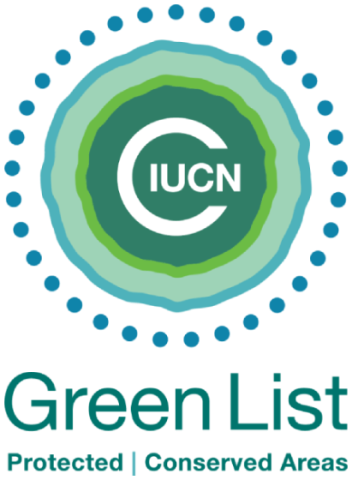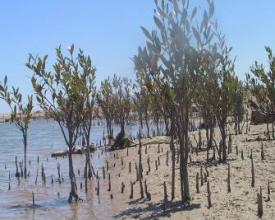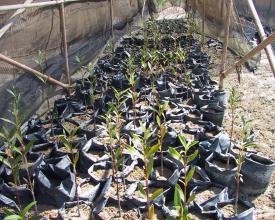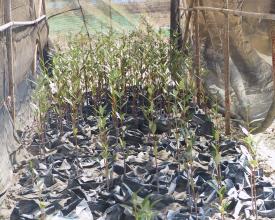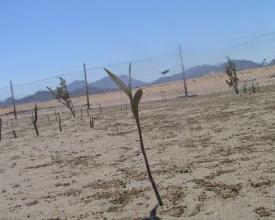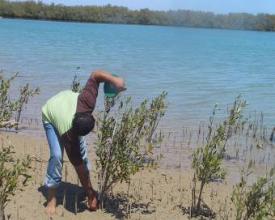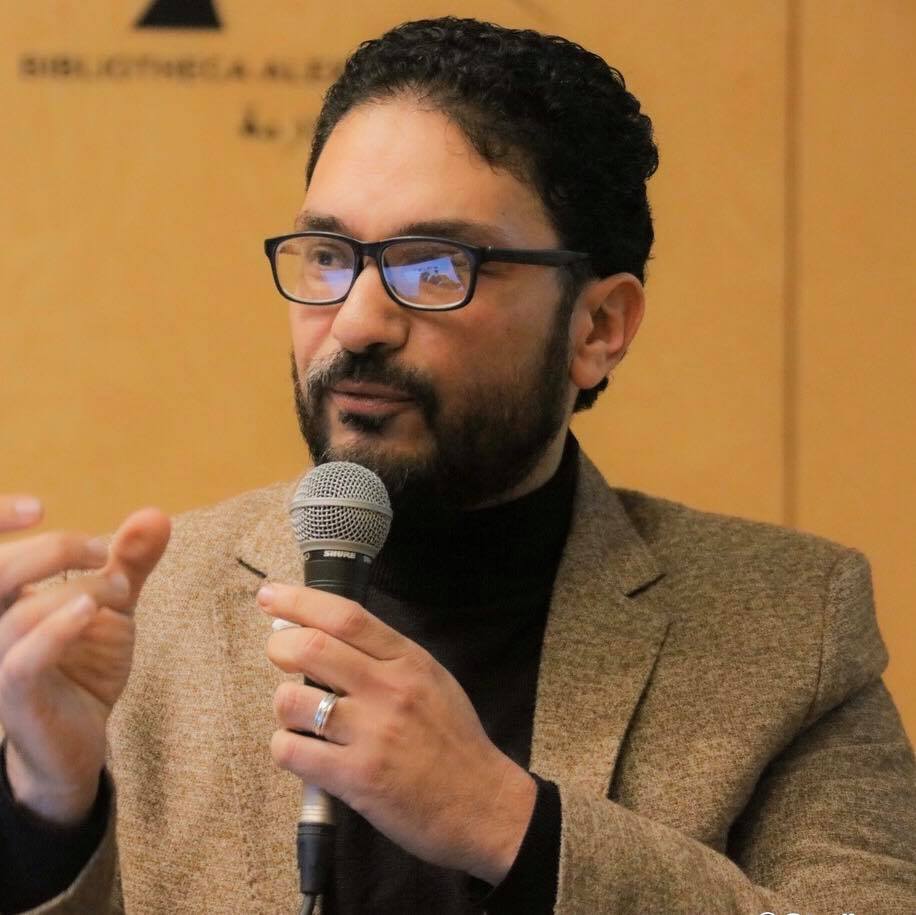
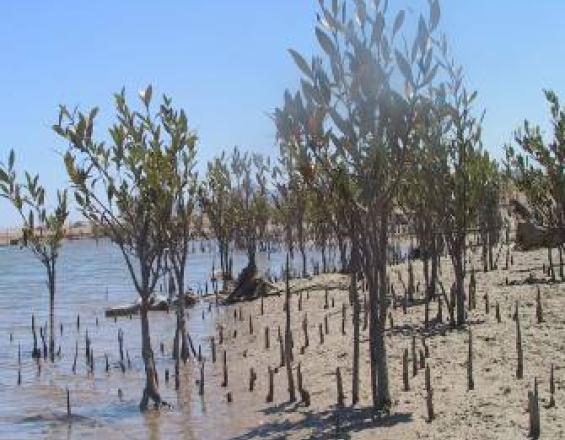
Plantation de mangroves.
Tarek Temraz, EEAA
En 2001, une dégradation des peuplements de mangroves en Égypte a été constatée en raison de l'urbanisation et d'un manque de sensibilisation. Une étude de reboisement des mangroves à petite échelle a été menée à Sharm Elshiek, Nabq, axée sur la plantation, la transplantation, le suivi et l'évaluation des peuplements de mangroves avec l'intégration des principaux bénéficiaires, les communautés locales. La réhabilitation a permis la régénération des peuplements et une augmentation globale de la croissance de la zone d'occupation a été enregistrée.
Dernière modification 08 Feb 2023
7169 Vues
Contexte
Défis à relever
Cette solution s'attaque aux impacts sur les peuplements de mangrove de la région de Nabq qui sont principalement causés par les activités humaines telles que la collecte de bois, la pollution environnementale (terrestre et marine), le surpâturage par les chameaux, le glanage d'animaux (larves de poissons et d'invertébrés) ainsi que le développement de la zone côtière. Le manque de sensibilisation aux questions de conservation de la biodiversité peut être considéré comme la principale source de difficultés.
Emplacement
Ras Mohamed, Qesm Sharm Ash Sheikh, Sud-Sinaï, Égypte
Afrique du Nord
Traiter
Résumé du processus
Une expérience à petite échelle a été menée à Sharm Elshiek, Nabq, pour tester localement le reboisement des peuplements de mangrove en déclin sur tout le littoral égyptien. Pour assurer la durabilité du projet et impliquer la population locale, il a fallu commencer par une campagne de sensibilisation au sein des communautés de Nabq. Grâce à la nouvelle compréhension de la valeur de l'écosystème pour leur subsistance, les habitants se sont portés volontaires pour aider l'EEAA à planter et à transplanter des graines et des jeunes plants dans la zone prévue à cet effet, ainsi qu'à protéger et à nettoyer les peuplements touchés à Sharm Elshiek. Afin de prouver l'impact de ces efforts et de créer une base pour la reproduction du projet, un suivi de l'écosystème a été effectué. Afin d'obtenir plus d'informations sur la valeur réelle et de souligner la nécessité de reproduire les activités de reboisement et de protéger les peuplements de mangrove non seulement dans la région de Nabq en Égypte, l'écosystème a été évalué en fonction des services et des biens qu'il fournit à la population égyptienne. Les informations relatives au suivi et à l'évaluation peuvent désormais être utilisées pour sensibiliser à la protection des mangroves dans d'autres zones touchées en Égypte.
Blocs de construction
Campagne de sensibilisation
Approche participative avec les populations locales sur l'importance de la mangrove - Protection du littoral - Zones de reproduction pour les poissons et les crevettes - Maintien des moyens de subsistance Sensibiliser les populations à leur dépendance à l'égard de l'écosystème.
Facteurs favorables
- Implication des populations locales - Analyse préalable de la situation et identification claire de l'impact pour une bonne base de communication - Application de mesures incitatives et partage des bénéfices
Leçon apprise
- La participation des populations locales à la gestion des zones protégées et à la protection de l'écosystème est essentielle à la réussite du processus de conservation.
Accroître les efforts de conservation
1. Réduire la pression sur les mangroves en réduisant l'impact sur les peuplements de mangroves d'origine, en installant une clôture autour des peuplements replantés, en nettoyant les peuplements de mangroves existants de la pollution par les hydrocarbures et les déchets solides. 2. Retirer les semis et les graines de la zone touchée et les planter dans des endroits désignés. 400 plants ont été transplantés dans la pépinière de la zone de Gharqana dans la zone protégée de Nabq le 16/7/2006. Après trois ans et demi, environ 255 plants étaient encore en vie. Le travail a été effectué par le personnel de l'EEAA en collaboration avec des bénévoles locaux. L'emplacement a été choisi par des experts.
Facteurs favorables
à confirmer
Leçon apprise
à confirmer
Évaluation de l'écosystème de la mangrove
Identification des services et des biens fournis par les mangroves afin de faciliter une gestion et une conservation appropriées dans les différents secteurs. Ce travail a été réalisé par l'EEAA et le NBSAP. Une partie de l'évaluation était par exemple une étude biologique menée sur les arbres de mangrove (hauteur, volume, densité, production de fruits et période de floraison) qui a prouvé que les habitats de mangrove sont caractérisés par une grande biodiversité.
Facteurs favorables
à confirmer
Leçon apprise
à confirmer
Impacts
- Le projet de reboisement des mangroves a été reproduit dans plusieurs autres zones le long de la mer Rouge, en particulier dans les zones dégradées avec des peuplements de mangroves indigènes - La collecte de larves de poissons et d'invertébrés s'est arrêtée en raison de l'application de la loi par les populations locales. Conscients de l'importance de l'écosystème pour leurs moyens de subsistance, les habitants ont réduit leur impact et les stocks de poissons et d'invertébrés se sont reconstitués - L'objectif de l'effort de reboisement a été atteint puisque les mangroves de la région de Nabq se sont reconstituées et que leur densité est supérieure à celle enregistrée en 2001. La réhabilitation a permis d'améliorer la croissance et la régénération du peuplement et d'enregistrer une croissance globale et une augmentation de la zone d'occupation.
Bénéficiaires
La population locale de Sharm Elshiek, la zone pilote de Nabq et la politique nationale.

